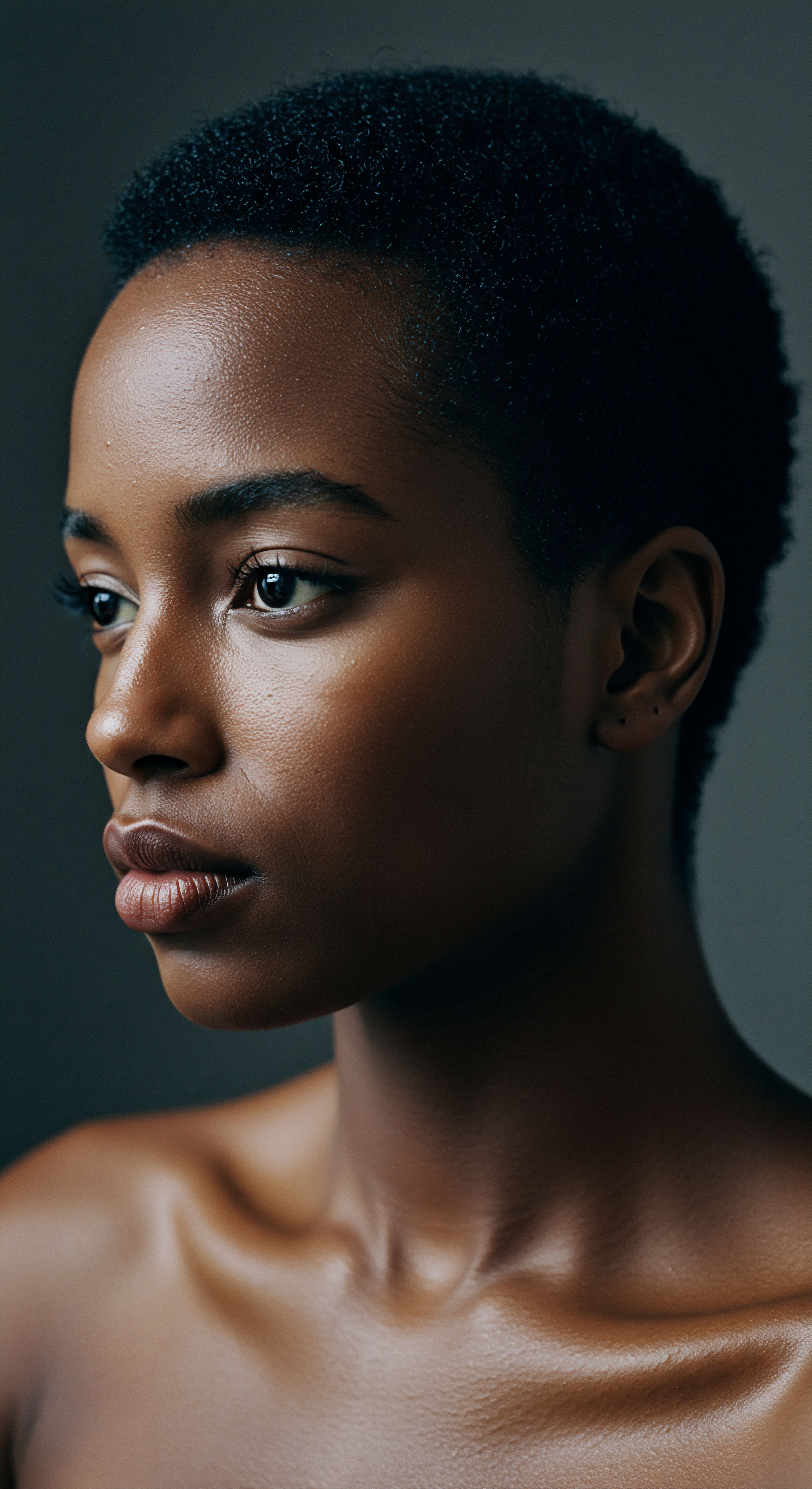
Roots
As twilight descends, a quiet transformation begins for many, a moment of preparation before rest. We consider our sleep a period of restoration, a time when the body recalibrates, mends, and renews. For our hair, particularly textured strands, the hours of slumber hold a similar potential for rejuvenation or, conversely, for subtle, unnoticed wear.
The bonnet, a seemingly simple garment, enters this nightly tableau not merely as an accessory, but as a silent architect of a contained environment, a personal haven for hydration. Uncovering the influence of this enclosed space on hair’s water balance overnight requires a look at the very foundation of hair itself and its deep relationship with moisture.
Hair, in its fundamental structure, reveals a marvel of biological design. Each strand, emerging from the scalp, is far more than a simple fiber. It possesses a complex architecture, a layered composition that dictates its strength, elasticity, and, critically, its interaction with the surrounding atmosphere. At the core lies the Cortex, a bundle of keratin proteins responsible for the hair’s primary mechanical properties.
Encasing this core is the Cuticle, a protective outer layer comprised of overlapping, scale-like cells. These scales, when healthy and smooth, lie flat, creating a barrier that helps seal moisture within the hair shaft. When these scales lift, whether due to damage or environmental factors, the hair becomes more susceptible to losing its precious water content.

The Hair Shaft and Water’s Affinity
Water, the universal solvent, holds a profound connection with hair. The keratin proteins within hair possess a natural affinity for water molecules, primarily through hydrogen bonds. These bonds are temporary, forming and breaking with the presence or absence of water. When hair absorbs water, these hydrogen bonds are disrupted, causing the hair shaft to swell.
This swelling is a physical manifestation of hydration, altering the hair’s dimensions and mechanical characteristics. The degree to which hair absorbs and holds water is largely governed by its Porosity, a characteristic determined by the state of its cuticle layer.
- Low Porosity Hair ❉ Characterized by tightly closed cuticle scales. This structure makes it challenging for moisture to enter the hair shaft, yet once inside, water is retained well.
- Normal Porosity Hair ❉ Features cuticles that are neither too tightly bound nor too open, allowing for a balanced absorption and retention of moisture.
- High Porosity Hair ❉ Marked by raised or compromised cuticle scales, which allow moisture to enter quickly but also escape with equal speed. This type often experiences dryness and frizz.
Understanding these intrinsic qualities of hair sets the stage for appreciating how an external element, like a bonnet, can profoundly influence its nightly journey toward hydration. The goal is not simply to add water, but to foster an environment where hair can maintain its optimal water balance, preserving its natural resilience and appearance.
Hair’s complex structure, especially its cuticle, dictates how it interacts with moisture, influencing its ability to remain hydrated.
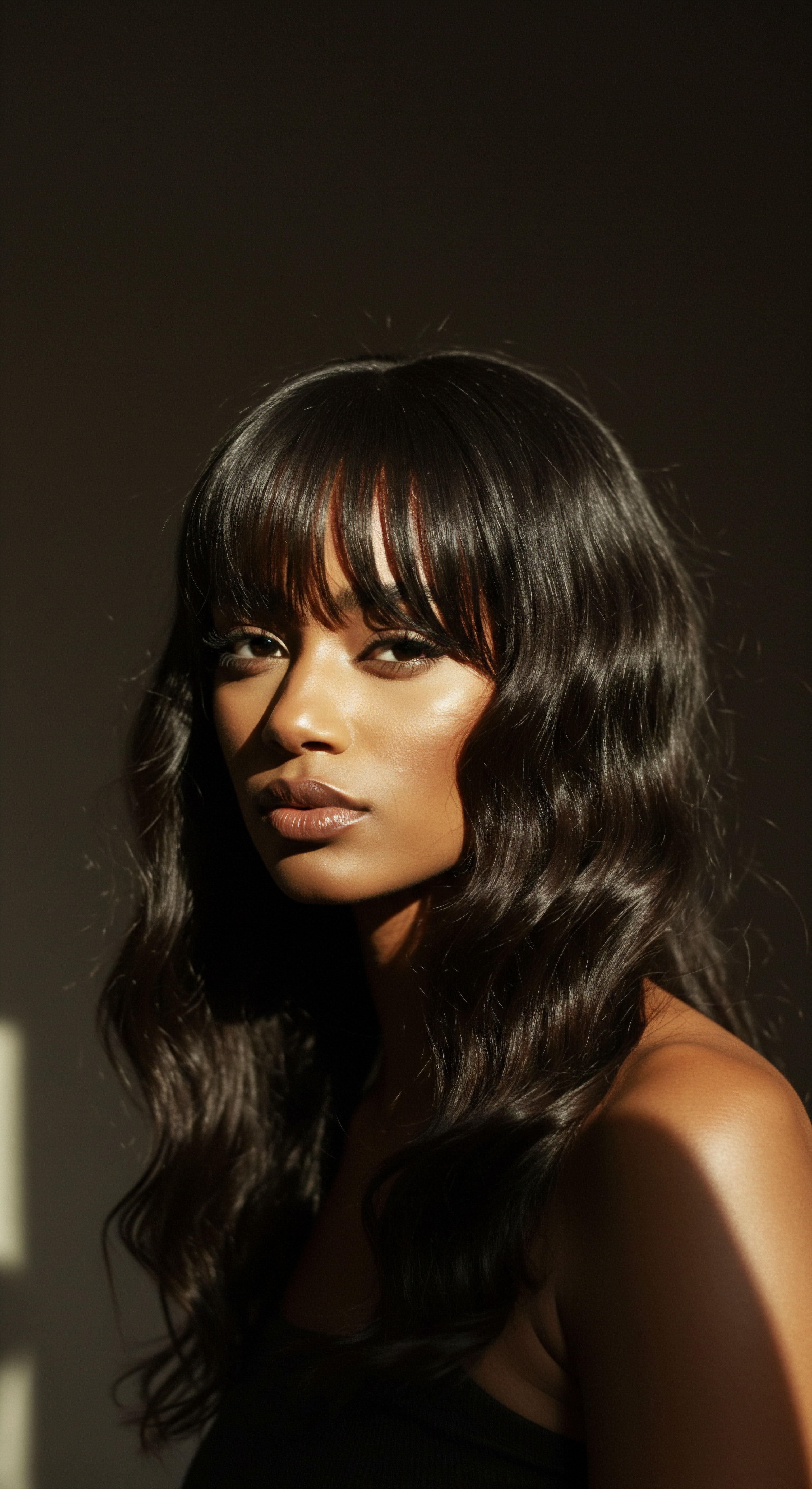
A Glance at Water Loss
Even as we sleep, our hair is subject to environmental factors that influence its moisture content. The ambient humidity of a room, the friction from pillowcases, and even the body’s natural heat all play a part in a subtle, continuous process of water exchange. Without protection, hair can lose water to the surrounding air, particularly in dry environments or due to absorbent bedding materials like cotton.
This continuous loss can lead to dryness, brittleness, and a compromised appearance upon waking. The thoughtful use of a bonnet aims to counter these forces, creating a more controlled setting for the hair to rest.
The mechanisms of water movement in and out of hair are scientifically observed using techniques such as Dynamic Vapor Sorption (DVS) and Thermogravimetric Analysis (TGA). These methods measure how hair samples gain or lose mass as humidity or temperature changes, providing precise data on water content and the rate of its uptake and release. Such scientific tools allow researchers to quantify the hair’s response to its atmospheric surroundings, providing a foundation for understanding the practical benefits of protective head coverings.

Ritual
The soft rustle of a bonnet settling over styled strands at bedtime signals a shift from the day’s demands to a period of gentle care. This nightly practice, for many with textured hair, transcends a mere habit; it becomes a deliberate act of preserving hair’s health and integrity. The practical wisdom behind this routine, honed over generations, now finds support in scientific observation. We step into a space where everyday techniques meet their underlying mechanisms, where the simple act of donning a bonnet becomes a key element in maintaining hair hydration through the night.

Crafting a Microclimate
At the heart of the bonnet’s efficacy lies its capacity to establish a distinct Microclimate around the hair. Unlike the open air of a bedroom, which can fluctuate in humidity and temperature, the bonnet creates a confined space. This enclosure traps the natural moisture evaporating from the scalp and hair, increasing the relative humidity within the bonnet. When the surrounding air outside the bonnet is dry, this localized, higher humidity environment significantly reduces the hair’s tendency to lose water.
Consider the difference in materials ❉ a cotton pillowcase, with its absorbent fibers, acts like a sponge, drawing moisture directly from the hair. This can lead to increased friction and dryness, especially for textured hair which is already prone to dehydration due to its unique structure. A bonnet, particularly one crafted from materials like silk or satin, presents a smooth, less absorbent surface.
- Silk Bonnets ❉ These are celebrated for their natural protein fibers that are inherently less absorbent than cotton. Silk allows hair to retain its natural oils and applied moisture, contributing to sustained hydration.
- Satin Bonnets ❉ Often made from synthetic materials, satin provides a smooth surface that minimizes friction. While generally less breathable and absorbent than silk, it still offers significant advantages over cotton for protecting hair and helping to hold moisture.
The smooth surface of silk or satin also plays a crucial role in reducing Mechanical Friction. As a person shifts during sleep, hair rubs against surfaces. On rougher fabrics, this friction can lift and damage the hair’s delicate cuticle scales, leading to frizz, tangles, and breakage.
Within a silk or satin bonnet, hair glides smoothly, preserving the cuticle’s integrity and thus helping to seal in moisture more effectively. This protective action is especially important for textured hair, which naturally has more points of contact and is more susceptible to friction-induced damage.
A bonnet cultivates a localized humid environment around hair, reducing moisture loss and friction during sleep.
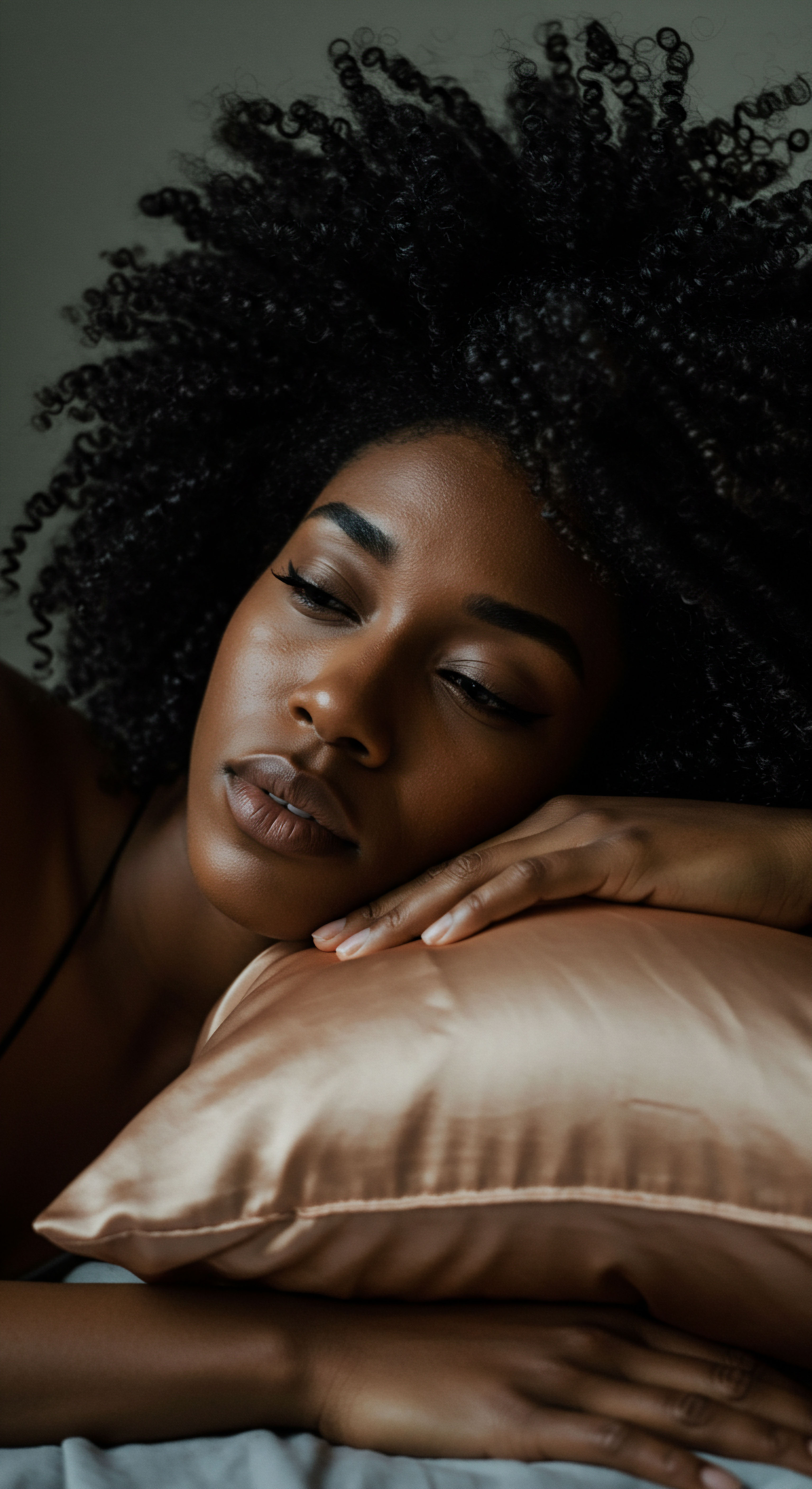
How Bonnets Counter Moisture Loss
The scientific principle at play is akin to creating a mini-humidifier for the hair. Our bodies naturally release heat and some moisture, even during sleep. Within the enclosed space of a bonnet, this released moisture is largely contained. This elevates the Relative Humidity (RH) directly around the hair strands.
Hair, being hygroscopic, will seek to equilibrate its water content with the surrounding air. If the air outside the bonnet is dry, the hair would naturally lose water. However, by maintaining a higher RH inside, the bonnet minimizes this evaporative loss.
A study on hair water content measurements highlighted that healthy hair will contain different amounts of water when exposed to varying relative humidity environments. By consciously altering the micro-environment around the hair, bonnets actively support its optimal water balance overnight. This prevents the hair from drying out, becoming brittle, or experiencing the repeated swelling and shrinking that can contribute to hygral fatigue, a condition where hair weakens from excessive water absorption and subsequent drying.
| Material Type Cotton |
| Friction Level High |
| Moisture Absorption High (absorbent) |
| Impact on Hair Cuticle Lifts, damages, leads to frizz and breakage |
| Material Type Satin (Synthetic) |
| Friction Level Low to Medium |
| Moisture Absorption Medium (less than cotton) |
| Impact on Hair Cuticle Reduces lifting, minimizes damage |
| Material Type Silk (Natural) |
| Friction Level Very Low |
| Moisture Absorption Very Low (retains moisture) |
| Impact on Hair Cuticle Preserves integrity, seals in moisture |
| Material Type Choosing the right material for overnight hair protection significantly impacts hair health and hydration. |

Relay
Beyond the immediate, tangible benefits of a bonnet, how does this seemingly simple head covering truly interact with the subtle, intricate dance of hair hydration at a deeper level, where science and sensory perception meet? We journey now into the less obvious, yet profoundly significant, aspects of the bonnet’s influence, moving past surface observations to the molecular and even the cultural underpinnings of this nightly practice. The bonnet does more than just protect; it facilitates a sustained, gentle exchange that supports the hair’s long-term well-being.
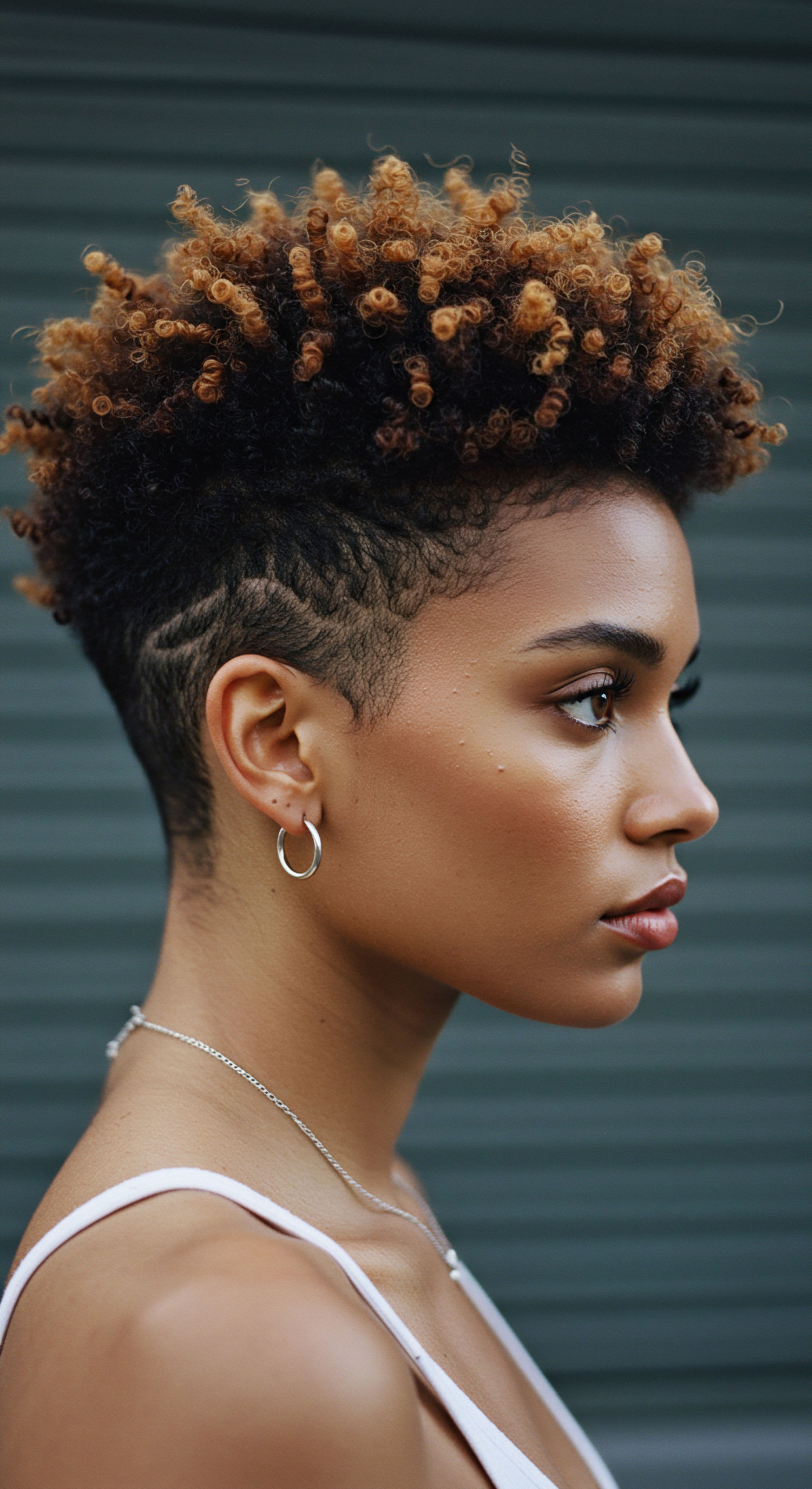
The Thermodynamics of a Bonnet’s Inner Space
The internal microclimate of a bonnet is not static; it is a dynamic system influenced by the body’s natural thermoregulation. As we sleep, our scalp and hair emit a small amount of heat and water vapor. Within the enclosed bonnet, this vapor becomes concentrated, raising the localized humidity. This elevation in humidity is crucial because it reduces the Vapor Pressure Gradient between the hair and its immediate surroundings.
A steeper gradient encourages water to evaporate from the hair. By diminishing this gradient, the bonnet slows down the rate of water loss, allowing the hair to remain hydrated for extended periods. This phenomenon is particularly significant for hair that has been pre-moisturized with water-based products, as the bonnet helps to seal in those hydrating agents, giving them ample time to absorb into the hair shaft.
The choice of bonnet material further refines this thermal and moisture balance. Silk, a natural protein fiber, possesses unique temperature-regulating properties. It is breathable, allowing for some air circulation while still maintaining a humid environment. This breathability helps prevent overheating and excessive sweating within the bonnet, which could otherwise lead to a damp, rather than merely hydrated, environment.
Excessive dampness could potentially encourage microbial growth on the scalp or lead to hygral fatigue for certain hair types, where repeated swelling and shrinking from too much water can compromise hair structure. Satin, particularly synthetic satin, can be less breathable, potentially trapping more heat and moisture. While beneficial for moisture retention, it demands attention to ensure the environment does not become overly saturated.

Beyond Moisture Retention ❉ A Deeper Look at Hair’s Feel
The perception of “moisturized” hair often extends beyond its actual water content. Intriguingly, research suggests a disconnect between objective hydration measurements and consumer sensation. One study, using techniques like Dynamic Vapor Sorption (DVS), found that hair equilibrated at lower humidity was overwhelmingly preferred by consumers, who described it as feeling “more moisturized.” This was true even when technical measures showed no actual change in water content. This observation points to the profound role of surface properties and lubrication in the perception of hair hydration.
The perceived “moisturized” feel of hair can sometimes be influenced more by surface smoothness and lubrication than by actual water content.
A bonnet’s influence here becomes apparent. By reducing friction and preventing cuticle damage, silk and satin bonnets contribute to a smoother hair surface. This smoothness, even if the internal water content of the hair fiber itself hasn’t dramatically increased, can lead to a sensation of enhanced hydration and softness.
The gentle glide of hair against the smooth fabric prevents the lifting of cuticle scales, which would otherwise create a rougher surface and a perception of dryness or frizz. Therefore, the bonnet supports both actual moisture retention and the desirable sensory attributes associated with well-hydrated hair.

The Cultural Echoes of Head Coverings and Hair Care
The practice of covering hair at night, particularly within Black and mixed-race communities, carries a rich historical and cultural weight that transcends mere practical utility. Head coverings have been integral to African cultures for centuries, serving purposes ranging from status symbols and religious observance to practical protection against the elements. During periods of enslavement and beyond, headwraps and coverings became powerful symbols of resistance, identity, and dignity.
This deep cultural lineage informs the contemporary use of bonnets. The act of covering one’s hair at night is not just about preserving a hairstyle or retaining moisture; it is often an inherited ritual, a continuation of practices passed down through generations, reflecting a profound respect for hair as a crown and a connection to heritage. Anthropological studies highlight how hair practices, including covering, often signal social norms, group identity, and self-expression. The bonnet, in this light, becomes a tangible link to ancestral wisdom, a tool for nurturing not only the physical strands but also the cultural significance they hold.
The care given to textured hair, which is often more susceptible to dryness due to its coil pattern hindering the natural distribution of scalp oils along the strand, necessitates protective measures. The bonnet serves as a modern manifestation of this historical need for protection, adapting ancient practices to contemporary understanding of hair science. It bridges the gap between tradition and innovation, offering a solution that is both deeply rooted and scientifically sound.

How Does Hair Porosity Respond to a Bonnet’s Environment?
Hair porosity plays a significant role in how individual strands respond to the bonnet’s internal microclimate. For those with High Porosity Hair, whose cuticles are more open, the bonnet acts as a crucial barrier against rapid moisture evaporation. This hair type absorbs water quickly but also loses it just as swiftly.
The humid environment within the bonnet helps to slow down this outward movement of water, allowing the hair to maintain hydration for a longer period overnight. Without this protective barrier, high porosity hair would likely experience significant water loss, leading to increased frizz and brittleness upon waking.
Conversely, Low Porosity Hair, with its tightly bound cuticles, might initially struggle to absorb moisture. However, once hydrated, it retains water effectively. For this hair type, the bonnet’s gentle, consistent humidity can create a slightly more receptive environment for moisture absorption, without risking oversaturation.
The primary benefit here might be less about preventing rapid water loss and more about preserving the integrity of any applied products and minimizing friction that could still disturb the smooth cuticle. The bonnet ensures that whatever moisture has been lovingly applied to these strands remains undisturbed, allowing for deeper conditioning and less disruption of the hair’s surface.
This nuanced interaction with porosity underscores the bonnet’s versatility. It adapts its protective function to the specific needs of different hair structures, offering a tailored approach to overnight care.
- Cuticle Protection ❉ A bonnet’s smooth interior shields hair from friction, which can lift and damage the outer cuticle layer, a primary cause of frizz and dryness.
- Humidity Control ❉ By creating a localized humid environment, bonnets reduce the vapor pressure gradient, slowing down the rate of water evaporation from hair strands.
- Product Efficacy ❉ The enclosed space helps seal in leave-in conditioners and oils, allowing them more time to absorb and condition the hair without being lost to the air or absorbed by bedding.
- Thermal Regulation ❉ Silk bonnets, in particular, offer breathability that helps regulate temperature, preventing excessive sweating while maintaining optimal moisture.
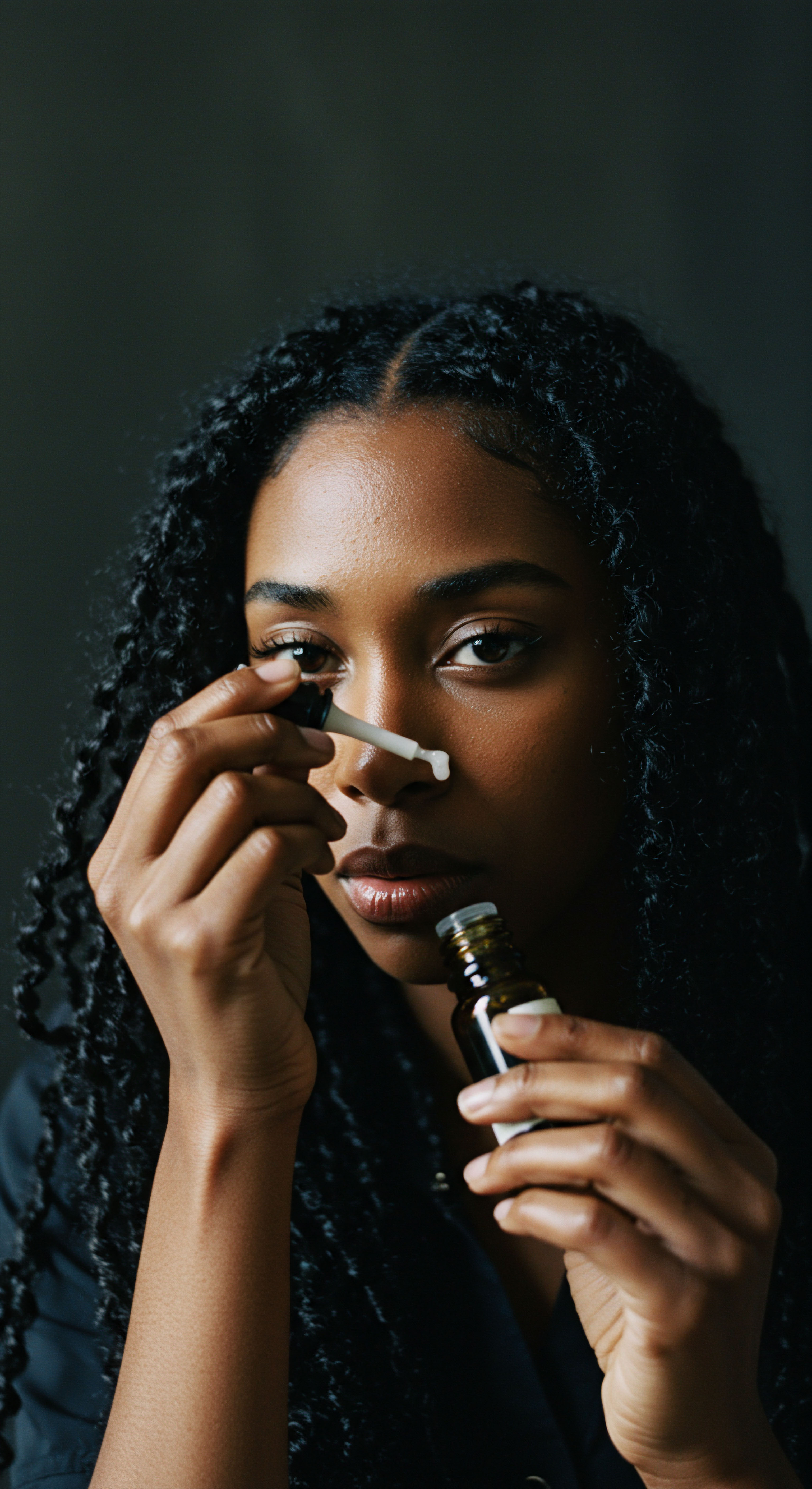
Reflection
The journey into the bonnet’s hidden world of microclimates reveals a compelling story, one where ancient practices and modern science intertwine. What begins as a simple garment, a gentle covering for the night, transforms into a sophisticated tool for hair health. It stands as a quiet guardian, fostering an atmosphere where textured strands can truly thrive, preserving their innate beauty and resilience. The bonnet is more than just a piece of fabric; it is a testament to the enduring wisdom of caring for our hair with intention and respect, a soft embrace that allows our crowns to rest and renew, ready to greet the light of a new day.

References
- TRI Princeton. Hair Moisturization Claims 101. 2024.
- Better Not Younger. How Humidity Affects Different Hair Types. 2022.
- OrganiGrowHairCo. Humectants and Hair Porosity ❉ Understanding Their Effects. 2024.
- Popescu, C. et al. Water content of hair and nails. ResearchGate.
- Kérastase Australia. How to Protect Your Hair Overnight. 2024.
- Rodrigues, L.A. et al. Evaluation of hair fiber hydration by differential scanning calorimetry, gas chromatography, and sensory analysis. Journal of Cosmetic Science. 2003.
- NAJEAU. Humidity’s Impact on Hair & Scalp.
- Obé Headwear. Significance of headwraps. 2024.
- Goldsmiths, University of London. Changing perceptions of hair.
- Slipssy. Slipssy’s First-Night Effect ❉ How Reducing Friction Transforms Your Hair Overnight. 2025.
- Smooth & Charming. How Humidity Affects Your Hair and What to Do. 2024.
- Gisou. 10 Simple Tricks to Keep Your Hair From Getting Frizzy Overnight. 2023.
- Lee, S.H. et al. Understanding the Characteristics of the Scalp for Developing Scalp Care Products. Cosmetics. 2018.
- NaturAll Club. How To Keep Your Hair Moisturized Overnight. 2020.
- Rossano Ferretti Parma. Causes and prevention of humidity hair.
- Xiao, P. et al. Hair Water Content and Water Holding Capacity Measurements. 7th International Bi-Annual Conference on Applied Hair Science. 2016.
- Xiao, P. et al. Hair Water Content and Water Holding Capacity Measurements. CORE.
- Robbins, C.R. Measuring the Water Content of Hair. Cosmetics & Toiletries. 2014.
- Active Concepts. Hair Hydration Comparison Assay.
- Liu, X. et al. Evaluation of hair humidity resistance/moisturization from hair elasticity. Journal of Cosmetic Science. 2007.
- It’s Not Just Hair ❉ Historical and Cultural Considerations for an Emerging Technology. Chicago-Kent Law Review. 1999.
- Yagi, M. et al. Near-infrared imaging of water in human hair. Journal of Cosmetic Science. 2009.
- Reinking, A. et al. New Topicals to Support a Healthy Scalp While Preserving the Microbiome ❉ A Report of Clinical and in Vitro Studies. Journal of Clinical and Aesthetic Dermatology. 2023.
- Vianna, A.G. et al. Application of a tensile-strength test method to the evaluation of hydrating hair products. International Journal of Cosmetic Science. 2005.
- Mandom Corporation. Mandom reveals the actual state of the easily damaged male scalp and the improvement effect of scalp lotion. 2015.
- JD Institute of Fashion Technology. HEADWRAPS ❉ HISTORY AND EVOLUTION. 2021.
- Quora. Why did my hair texture change overnight like it feels brittle and dry out of nowhere? 2024.
- Malefyt, T. de W. The Senses in Anthropological and Marketing Research ❉ Investigating a Consumer-Brand Ritual Holistically. CBS Open Journals. 2015.
- Fashionista. How to Protect Curly and Coily Hair Overnight, According to Experts. 2024.
- The Silk Collection. Silk Bonnet vs. Satin Bonnet | Why Use Real Silk Bonnets | Silk Hair Bonnet.
- Taylor & Francis Online. Scalp Biophysical Characteristics in Males with Androgenetic Alopecia ❉ A Comparative Study with Healthy Controls. 2021.
- Blissy. Is Silk or Satin Better for Hair? TikTok’s Viral Hack vs. Science. 2025.
- Dr. Serkan Aygin. Low vs. High Porosity Hair ❉ Key Differences & Hair Care. 2025.
- Wilderness Safaris. The history & meaning of head wraps across Africa. 2015.
- Dove Medical Press. Scalp biophysical characteristics in androgenetic alopecia. 2021.
- Theology in the raw. The Cultural Context for the Hair Length/Style vs. Head-coverings Debate in 1 Cor 11 ❉ The Meaning of Kephalē part 12. 2024.
- I Love Riccio. How not to damage curly hair at night.
- Slipssy. The Long-Term Effects of Slipssy ❉ Protecting Your Hair Follicles, Pres. 2025.
- OrganiGrowHairCo. Natural Hair Moisture Retention Challenge For Dry Hair. 2024.
- Boucleme. Sleeping with curly hair ❉ how to protect curls overnight. 2022.
- Center for South Asian and Middle Eastern Studies. Cross-Culture Head Coverings.
- AfroCurls. Moisturizing Your Hair ❉ A Three-Step Process. 2019.
- uk-silksilky. Silk vs. Satin Bonnet Showdown ❉ Why Silk Reigns Supreme for Hair Health.
- Amerisleep. Benefits of Sleeping in a Bonnet ❉ Why You Should Do It. 2024.
- Hair Cuticle Care ❉ The Complete Guide to Protecting and Strengthening Your Hair. 2024.
- MDPI. Hair Lipid Structure ❉ Effect of Surfactants. 2023.